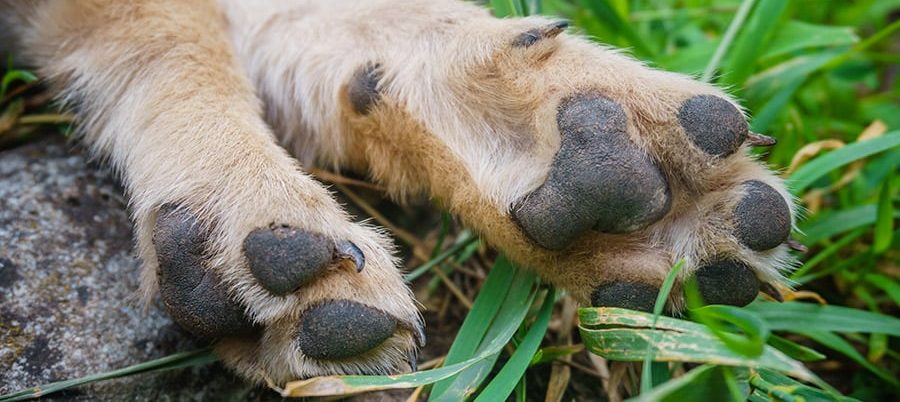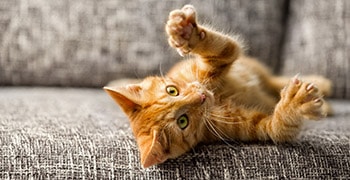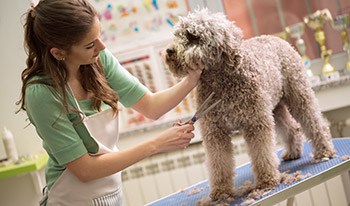
So, do Labradoodles have dewclaws? Yes, Labradoodles are born with front dewclaws. They are located on the inside of each front leg, just above the paw and before the ankle. If a Labradoodle doesn’t have a dewclaw, it was removed shortly after birth by the breeder or veterinarian.
After messaging the breeder, I was able to confirm that Oliver was indeed born with his dewclaws, but they were removed when he was just 2 days old.
Aside from feeling sorry for the little guy for having to go through that, I was left with even more questions. So I’ve answered those questions (and a few extra ones) for you in this article.
What Is A Dewclaw?
A dewclaw is a dog’s 5th digit. You can kind of think of it as a dog’s thumb or big toe, while not necessarily as crucial. Usually, a dog’s front dewclaw is much more substantial and is attached by bone and muscle. The rear dewclaw is usually just attached by a small piece of skin, making it pretty floppy and not very useful.
Labradoodles are typically born with dewclaws on only their front legs. In rare instances, they may be born with rear dewclaws. Many breeds, like Saint Bernards and Great Pyrenees, are born with both front and rear dewclaws. Some might even be born with double rear dewclaws.
Do Dewclaws Have a Purpose?
The front dewclaws (the ones attached by bone) definitely serve a purpose for a dog. In many breeds, they actually make contact with the ground as they’re running. As you’ll see here below, they can:
- Help a dog hold objects as they chew them
- Help them climb trees
- Provide extra traction when running or turning
- Help allow the dog to rub their eyes (I’m not sure I believe that one)
Dewclaw Removal
As I said earlier, Oliver’s dewclaws were removed when he was just 2 days old. The more research I did on the topic, I wasn’t really sure how I felt about it. I mean, it seemed like something he’d have benefited from keeping.
When I asked her about it, she said ‘there’s really no need for them’… ‘they have a tendency to get caught on things’. But, from what I’ve found, it’s pretty common for people to have their dog’s dewclaws removed.
Why People Remove Their Dogs Dewclaws
- Many argue that the dewclaw is a ‘weak digit’ that’s barely connected to the body, making is prone to snagging on things and possibly tearing or ripping completely off. If it tears and goes unnoticed, this can lead to bad infection.
- Because the dewclaw nails are more hidden than the other nails, they are sometimes forgotten and the nail overgrows. Overgrown dewclaws can dig into the dog’s leg and cause pain and possibly injury.
- For some show dog breeds, the owner will opt to have the dewclaw removed simply for cosmetic reasons.
After reading through message boards and forums, it seems that the biggest reason people have them removed is to prevent them from being ripped off. There are countless stories of hunting dogs getting their dewclaws caught on tree limbs, brush, and vines and them being ripped right off.
Others told stories of them getting ripped out from normal play in the backyard. When a dog’s dewclaw nail gets caught and rips out, there’s going to be a lot of blood. That’s because their nails have something in them called a quick. It’s located where the nail meets the flesh and provides blood supply. It’s a big debate in the K-9 community and I can definitely see both sides of the argument.
When To Remove Dewclaws (if you choose to)
According to PetMD, if you do choose to remove your pup’s dewclaws, it should be done when they’re very young, 2-5 days old. At this age, the bone structure is quite soft and not completely established, which makes it a relatively simple procedure.
Done at this age it only requires local anesthesia and heals quickly. If you wait until the dog is older, it’s a more involved and painful procedure. Looking to get a puppy? If you’d like to have your pup’s dewclaws removed, it’s best that you discuss that with the breeder beforehand.
Many breeders frown upon the idea of having dewclaws removed. So you’ll want to make sure they support that decision and will help arrange the procedure.
Things to consider
If you’re considering having your Labradoodle pups dewclaws removed, make sure you weigh out the pros and cons. If your dog will lead a pretty normal life when it comes to activities and exercise, it might not be necessary. On the other hand, if you’re hoping to get your dog involved in agility or sports like treibball, having them removed might be a good preventive precaution.
Related Questions
Can you have all your dog’s claws removed?
You’re probably heard of cats being de-clawed (having their claws removed) in cases where they tear up furniture or are aggressive to people and other animals. Well, that same procedure, known as canine onychectomy can be performed on dogs. Declawing of cats is seen by many as inhumane as it removes their ability to defend themselves.
This procedure is seen as even more inhumane for dogs. It’s actually down-right abuse. Cruelty! You’ll be hard-pressed to find a veterinarian who will even consider it, except in extremely rare instances.
How often should Labradoodles’ nails be trimmed?
It’s recommended by vets that you have your dog’s nails trimmed or cut every 30-days. Overgrown nails can cause irritation when they walk or even become painful. Keeping your pups nails manicured well also reduces the chances of them getting caught or ripped out. This is especially true when it comes to the dewclaws.
How much does it cost to have a dog’s nails clipped?
You’ll pay between $10-15 to have your dog’s nails trimmed. It really depends on if you’re going to a groomer or having it done at the vet’s office. When your dog is a puppy, they’ll be going to the vet frequently for their vaccinations and immunizations.
When you go, ask the vet or vet tech if they can clip their nails for you while you’re in. Many times, they won’t even charge you, so it’s definitely worth asking! Their nails can be pretty sharp and rough right after being clipped. So you might want to ask if they can also file the nails. If not, a nice walk will usually take the edge off (and it’s a great post-vet/groomer reward!).
That’s A Wrap!
There’s a ton of learning to be done when it comes to caring for your Labradoodle – that’s not different from any other breed, really. We hope to have answered all the questions you had around dewclaws and even some you wouldn’t have thought of. All-in-all, I’m glad that Oliver had his removed. Especially since it was done at such a young age.
I’d really like to get him involved in some agility training when he’s a little older, and think him not having dewclaws will prevent activity-related injuries. If you’re still unsure about keeping or removing your pups dewclaws, talk with a few breeders and your veterinarian.
Also, hope into some online forums or ask for some others’ opinions on Facebook. See what other people have to say and the experiences they’ve had. Education yourself before you make the decision because once you do, there’s no turning back.




